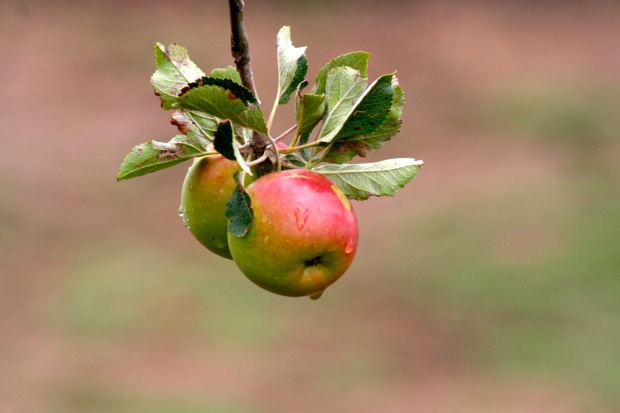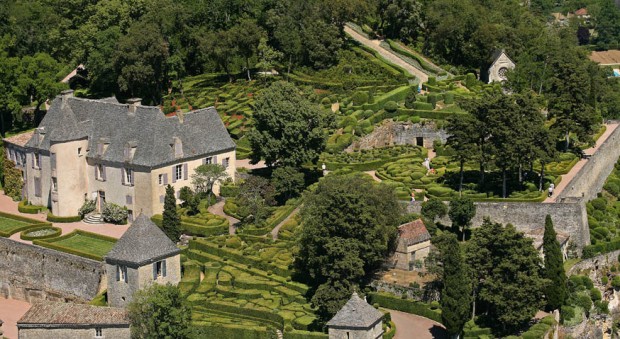The apples are bursting into life and I’m wishing I’d been more organised and ordered the heritage apples I plan to espalier around the fences enclosing the vegetable garden. Now it will have to be next winter. Inspired by the extraordinary orchard at RHS Wisley, I am planning an exciting display of old English and French cultivars. First on my list was the famous Cox’s Orange Pippin which will fruit for the first season this year. It is widely regarded as the finest of all dessert apples. Cox’s Orange Pippin ‘Pippin’ is an old English word derived from the French word for ‘seedling’. The same word can be seen in the modern French for a plant nursery or garden centre – ‘pepiniere’. Like many old apple varieties Cox’s Orange Pippin was discovered as a chance seedling. If you would like to research this further, here’s a link to the Heritage Fruits Society www.heritagefruitssociety.org.au/
About the Heritage Fruits Society
The Heritage Fruits Society is based in Melbourne, Australia. Their aim is to conserve heritage fruit varieties (also known as ‘heirloom fruits’) on private and public land. They enable and encourage society members to research this wide range of varieties and to inform the public on the benefits of heritage fruits for health, sustainability and biodiversity.
You can read about their history here and you can find their list of heritage apples here.
A list of some of the Heritage/Heirloom apples you might like to consider from Petty’s Orchard in Templestowe, Victoria, Australia. It is one of Melbourne’s oldest commercial orchards, and it holds the largest collection of heritage/heirloom apple varieties on mainland Australia, with more than two hundred varieties of old and rare apples. The maintenance of the apple tree collection is done by Heritage Fruits Society volunteers. Anyone can come and help. Find out more!
Petty’s Orchard Complete Heritage Apple Collection
Abas
Akane
Albany Beauty
Alexander
Alfriston Mother (=American Mother)
Andre Sauvage Antonovka Kameniohka
Atlanta
Autumn Tart
Baldwin
Ball’s Seedling
Barry
Bashfort
Batman’s Tree
Batt’s Seedling
Baumann’s Reinette
Beauty of Bath
Beauty of Stoke
Bec D’Oie
Bedford Pippin Cross
Bedfordshire Foundling
Belle de Boskoop
Belle de Magny
Berner Rosen
Bismarck
Blenheim Orange
Blue Pearmain
Bonza Boy’s Delight
Bramley’s Seedling
Breakwell’s Seedling
Brittle Sweet
Brown’s Apple
Browns Pippin
Bulmer’s Norman
Buncum
Butters Early Red
Carolina Red June
Cataignier
Cayuga
Cayuga Redstreak
Chandler
Cimetiere du Pays
Cleopatra
Climax
Coldstream Guard
Cornish Aromatic
Cornish Gilliflower
Cox’s Orange Pippin
Cox’s Orange Pippin Red
Cox’s Pomona
Cranberry Pippin
Crofton
Crofton Red
Dabinett
Delicious
Caldicott
Delicious Glen Vimey
Delicious Hi Early
Delicious Richared
Delicious Starkrimson
Democrat
Democrat (Black)
Devonshire Quarrenden
Dewdney’s Seedling
Discovery Doctor Hogg
Dunn’s Seedling (Monroe’s Seedling)
Duquesne
Early Victoria
Edward VII
Edwards Coronation
Eggleton Styre
Egremont Russett
Eldon Pippin
Ellison’s Orange
Emneth Early (=Early Victoria)
Esopus Spitzenburg
Esopus Sptizenburg
Fameuse (=Snow Apple)
Fenouillet Gris
Forfar Pippin
Forge
French Crab (=Winter Greening)
Freyberg
Frost
Fuji
Gala
Geante D’Exposition
Geeveston Fanny
Geoff’s Tree
George Carpenter
George Neilson
Gildering Sage D’espagne
Gladstone
Golden Delicious
Golden Harvey (=Brandy Apple)
Grandmere
Granny Smith
Gravenstein
Gravenstein Early
Grosseille
Hollow Crown
Holly
Hubbardton Nonsuch
Hyslop Crab
Ida Red
Improved Foxwhelp
Irish Peach
Isaac Newton’s Tree
James Grieve
Jaunet
Jerseymac
Jonagold
Jonared
Jonathan
Jonathan Red
Jongrimes
July Red
Keswick Codlin
Kidds Orange Red
King Cole
King David
King of the Pippins
King of Tompkins County
Kingston Black
Kirk’s Seedling
Lady Finger
Lady William
Lalla
Laxton’s Fortune
Laxton’s Superb
Legana
Lodi
London Pippin (Five Crown)
Lord Derby
Lord Lambourne
Lord Nelson
Lord Suffield
MacIntosh Early
Magnolia
Maigold
McIntosh Early
Melba
Melrose
Merton Worcester
Michelin
Minjon
Monarch Cross
Monroe
Murray Gem
Mutsu
Newtown Green Pippin
Nickajack
Norfolk
Northern Spy
Opalescent
Orange de per
Orleans Reinette
Ortley (=Cleopatra)
Peasgood’s Nonsuch
Pine Golden Pippin
Pittmaston Pineapple Fameuse (=Pomme de Neige)
Poor House
Potts’ Seedling
Prima
Prince Alfred
Prince Edward
Queen Cox
Quinte
Ranger
Red Astrachan
Red Delicious
Red Granny Smith
Red Winesap
Red Winter Pearmain (=Buncombe)
Reinette d’Angleterre
Reinette du Canada
Reinette Musque Rheinette de Macon
Rhode Island Greening
Ribston Pippin
Rokewood
Rome Beauty
Roundway Magnum Bonum
Rous La Tour
Royal Jubilee
Saint Edmunds Pippin
Saint Edmunds Russet
Scarlet Nonpariel
Scarlet Staymared
Scotia
Spartan
Splendour
Starkes Earliest
Starking Hi Early
Statesman
Stayman’s Winesap
Stewart’s Seedling
Summer Strawberry
Sunbury Late
Sundowner
Sweet Coppin
Symond’s Winter
Twenty Ounce
Tydeman’s Early Worcester
Upton Pyne
Vista Bella
Winter transparent Early
Woolbrook Russet
Worcester Pearmain
Yarlington Mill
Yates



